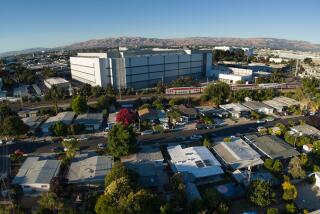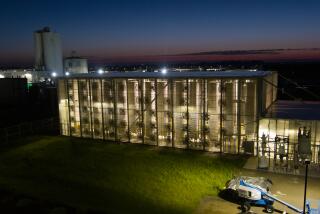Companies harness Earth’s heat
- Share via
Reno — Not far from the blinking casinos of this gambler’s paradise lies what could be called the Biggest Little Power Plant in the World.
Tucked into a few dusty acres across from a shopping mall, it uses steam heat from deep within the Earth’s crust to generate electricity. Known as geothermal, the energy is clean, reliable and so abundant that this facility produces more than enough electricity to power every home in Reno, population 221,000.
“There’s no smoke. Very little noise,” said Paul Thomsen, director of policy and business management for Ormat Technologies Inc., which owns the operation. “People don’t even know it’s here.”
Geothermal energy may be the most prolific renewable fuel source that most people have never heard of. Although the supply is virtually limitless, the massive upfront costs required to extract it have long rendered geothermal a novelty. But that’s changing fast as this old-line industry buzzes with activity after decades of stagnation.
Billionaire Warren E. Buffett has invested big. Internet giant Google Inc. is bankrolling advanced research. Entrepreneurs are paying record prices for drilling leases in places such as Nevada, where they’re prospecting for heat instead of metals.
“This is the new gold rush,” said Mark Taylor, a geothermal analyst with the consulting firm New Energy Finance in Washington. He credits high fossil fuel prices and concerns about global warming with jump-starting the U.S. industry, along with federal tax credits and state laws mandating the wider use of renewable energy.
Global investment in geothermal was around $3 billion last year, Taylor said. Although that’s a blip compared with the estimated $116 billion funneled into wind and solar, it’s still a 183% increase over investment in 2006. In a difficult year for alternative energy funding, the industry snagged $600 million through the first six months of 2008, Taylor said.
A lot of that new investment is in the United States, the world’s leader in geothermal energy. More than 80% of the country’s 3,000 geothermal megawatts lies in California. The Geysers, a network of 22 geothermal plants about 75 miles north of San Francisco in the Mayacamas Mountains, is the largest geothermal complex on the planet. Calpine Corp. owns the largest part of it.
The area around the Salton Sea in Imperial County is another hot spot. CalEnergy Generation, a subsidiary of Buffett’s Mid-American Energy Holdings, owns and operates 10 plants there. It plans three additional facilities in the next few years, CalEnergy President Steve Larsen said.
In October, the Bureau of Land Management said it planned to open more than 190 million acres of federal land in California and 11 other Western states for new geothermal development.
Nevada, the nation’s No. 2 geothermal producer, has 45 new projects underway, said Lisa Shevenell, director of the Great Basin Center for Geothermal Energy at the University of Nevada in Reno. An August lease sale of Nevada lands by the federal bureau brought in a record $28.2 million.
“I’ve been at this 25 years, and I’ve never seen anything like it,” said Shevenell, a research hydrologist. “Money is falling out of the sky.”
Geothermal has been harnessed for industry since at least the 1820s. Operators tap natural reservoirs of scalding water and steam trapped thousands of feet underground, drilling wells to bring the heat to the surface to power turbines that feed electricity generators.
Costing about 4 to 7 cents a kilowatt-hour, Taylor said, geothermal is competitive with wind power and significantly cheaper than solar. Geothermal facilities occupy a fraction of the space required by wind and solar farms. The energy is also more reliable. Plants crank electricity around the clock, irrespective of whether the sun is shining or the wind is blowing.
This so-called baseload generation is coveted by power companies, which are under pressure to boost their use of green energy. California utilities must generate 20% of their electricity from renewable sources by 2010. Nevada utilities must hit that target by 2015. Geothermal is a cornerstone of that effort, accounting for about two-thirds of the renewable portfolio of NV Energy, Nevada’s biggest utility.
“It’s a 24/7 predictable supply,” said Thomas Fair, the company’s head of renewable energy. “That means a lot to a utility.”
Greenhouse gas emissions are minimal in geothermal operations, and the size of the fuel supply defies imagination. There is 50,000 times more heat energy contained in the first six miles of the Earth’s crust than in all the planet’s oil and natural gas resources, according to the environmental organization Earth Policy Institute.
The challenge is extracting it. Geothermal energy production requires three things: heat from the Earth’s core, fractured rock to make it easy to get to and water to transport the heat to the surface.
Traditionally, developers have sought out pockets of hot water and steam hidden underground. Prime areas lie along continental plate boundaries, which is why California is such a hotbed.
Still, these reservoirs can be tricky to pinpoint. They’re also expensive to reach. A geothermal well can cost $5 million or more. The result: The U.S. currently derives less than 0.5% of its electricity from geothermal.
Some say the key to harnessing this energy source on a massive scale lies with a technology known as enhanced geothermal systems, or EGS for short. The idea is to engineer the necessary conditions by pumping water into the Earth’s crust and fracturing the hot rocks below. Heat from the Earth warms the water, whose resulting steam is channeled back to the surface, powering turbines to create electricity. The water is then pumped back underground.
Though still in its infancy, EGS has the potential to open up much of the planet to geothermal development. Tiny plants are already online in France and Germany. More than 30 EGS firms are engaged in exploration and development in Australia.
Google.org, the philanthropic arm of the Mountain View, Calif.-based search engine company, is trying to push EGS in the U.S. It recently gave $10 million to Southern Methodist University’s Geothermal Lab to update the nation’s geothermal resources map, as well as to two California companies -- Potter Drilling and AltaRock Energy Inc. -- that are working on EGS technologies.
Google is urging the U.S. government to spend big on geothermal R&D; as part of the company’s push to encourage utility-scale renewable energy that’s cheaper than coal. About half the United States’ electricity is generated by that dirty fossil fuel. China, already the world’s largest emitter of carbon dioxide, is adding coal-fired plants at a swift rate.
EGS “is indeed the sleeping giant of renewable energy,” Dan Reicher, director for climate change and energy initiatives at Google.org, said during a recent industry conference in Reno. “It’s the killer ap.”
Some industry veterans such as Shevenell are miffed that EGS has grabbed the spotlight when there’s plenty of energy to be extracted quickly using conventional techniques. Still, she credits Google for helping pump life into a dormant sector.
“This country is in an energy crisis,” she said. “We need energy now, and this is a proven way to get it.”
--
More to Read
Inside the business of entertainment
The Wide Shot brings you news, analysis and insights on everything from streaming wars to production — and what it all means for the future.
You may occasionally receive promotional content from the Los Angeles Times.










